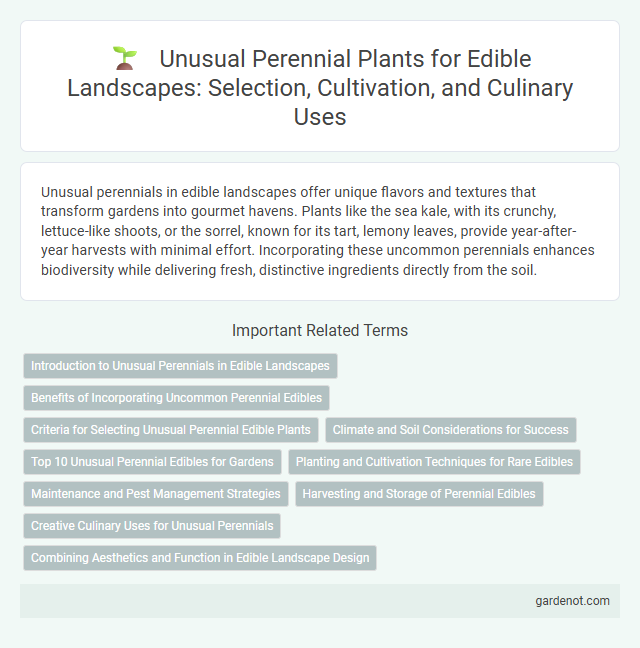Unusual perennials in edible landscapes offer unique flavors and textures that transform gardens into gourmet havens. Plants like the sea kale, with its crunchy, lettuce-like shoots, or the sorrel, known for its tart, lemony leaves, provide year-after-year harvests with minimal effort. Incorporating these uncommon perennials enhances biodiversity while delivering fresh, distinctive ingredients directly from the soil.
Introduction to Unusual Perennials in Edible Landscapes
Unusual perennials in edible landscapes introduce diverse flavors and textures beyond common garden staples, enhancing both aesthetic appeal and dietary variety. Plants like sea kale, Iraqi spinach, and Good King Henry offer unique growth habits and nutrient profiles, thriving with minimal care across various climates. Incorporating these perennials supports sustainable gardening by providing year-after-year harvests and reducing the need for replanting.
Benefits of Incorporating Uncommon Perennial Edibles
Incorporating uncommon perennial edibles such as sea buckthorn, sunchokes, and ground cherries enhances garden biodiversity and provides year-round nutritional harvests rich in vitamins and antioxidants. These unique plants often require less water and maintenance compared to traditional annuals, promoting sustainable gardening practices and reducing resource consumption. Their resilience to pests and adaptability to various soil conditions make them reliable food sources that contribute to food security and culinary diversity.
Criteria for Selecting Unusual Perennial Edible Plants
Choosing unusual perennial edible plants hinges on criteria such as climate adaptability, soil compatibility, and long-term yield stability. Prioritizing species with unique flavors, nutritional profiles, or medicinal properties enriches the edible landscape while ensuring sustainability. Resistance to pests and diseases is crucial for maintaining plant health without excessive chemical interventions.
Climate and Soil Considerations for Success
Unusual perennials in edible landscapes thrive best in well-drained, loamy soils with pH levels between 6.0 and 7.5, ensuring optimal nutrient availability. These plants require climates with moderate temperatures, avoiding extreme frost or prolonged drought, to maximize growth and fruiting potential. Proper site selection considering microclimates, such as sun exposure and wind protection, enhances survival and productivity of unique perennial edibles.
Top 10 Unusual Perennial Edibles for Gardens
Top 10 unusual perennial edibles for gardens include hardy kiwi, which produces sweet, grape-sized fruits ideal for cooler climates. Ground cherries offer a unique, tangy flavor encased in papery husks, thriving in well-drained soils. Another standout is Good King Henry, a spinach-like green known for its nutrient-dense leaves and tolerance to poor soil conditions.
Planting and Cultivation Techniques for Rare Edibles
Rare edible perennials like Good King Henry and Groundnut require well-drained soil enriched with organic matter to thrive. Planting in partial shade with consistent moisture promotes vigorous growth while preventing stress from intense sun or drought. Regular mulching and minimal disturbance to root zones enhance soil health and longevity of these unusual crops in sustainable edible landscapes.
Maintenance and Pest Management Strategies
Unusual perennials like Egyptian walking onions or sea kale require strategic maintenance practices including well-drained soil management and periodic mulching to promote healthy growth and reduce weed competition. Pest management strategies emphasize encouraging beneficial insects and implementing organic controls such as neem oil or insecticidal soaps to mitigate common pests like aphids and caterpillars. Proper crop rotation and regular monitoring further minimize disease incidence, ensuring sustainable production in edible landscapes.
Harvesting and Storage of Perennial Edibles
Perennial edibles like Good King Henry and Sea Kale require careful harvesting to ensure longevity and optimal flavor; harvest leaves and shoots in early spring before they become fibrous. Store harvests in cool, moist conditions such as a root cellar or refrigerated environment to maintain freshness and nutritional value. Proper handling and storage techniques can extend the usability of perennial edibles throughout the growing season and beyond.
Creative Culinary Uses for Unusual Perennials
Unusual perennials such as sorrel, lovage, and sea kale offer unique flavors and textures that elevate culinary creations with minimal gardening effort. Sorrel's tangy leaves brighten salads and soups, while lovage provides a celery-like aroma perfect for stocks and stews, enhancing depth and complexity. Sea kale's tender shoots serve as a seasonal gourmet vegetable, pairing well with butter or eggs for innovative, sustainable dishes in edible landscapes.
Combining Aesthetics and Function in Edible Landscape Design
Unusual perennials such as sunchokes, lovage, and sea kale offer unique textures and vibrant colors that enhance the visual appeal of edible landscapes while providing year-round harvests. Incorporating these plants balances ornamental beauty with practical yield, creating multifunctional garden spaces that delight both the eye and the palate. Selecting perennials that thrive in local climates ensures sustainable growth and maximizes the integration of aesthetics and functionality in edible garden design.
Unusual perennial Infographic

 gardenot.com
gardenot.com